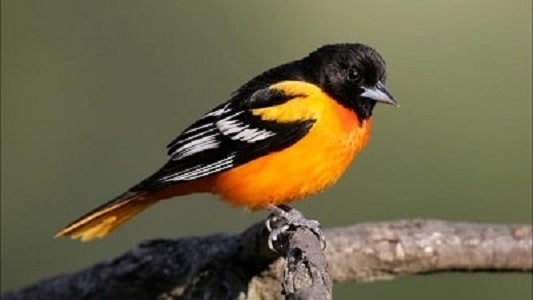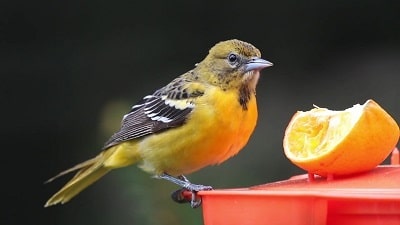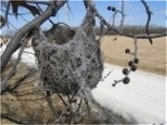All the Birds Are Here Again
Baltimore Oriole Habits Northern Oriole
In early Spring when the Baltimore Oriole bird makes its first appearance we receive emails asking if we can identify a bird that is black and also has "bright orange feathers". A bird you won't forget once you've seen one.
You know spring has sprung when you see and hear this bird at the top of trees making its rivals know he's claming territory.
The Baltimore Oriole bird makes its way from Mexico and South America its wintering grounds, to the US and Canada to begin its mating, nesting, and feeding habits.

Male Baltimore Oriole
Baltimore Oriole Call
Description
Northern Orioles measure 7 - 8 1/2 inches long. The male bird is black with orange underparts, rump, shoulders, and sides of tail. His wings have 2 white wing bars.
The females is olive above, yellowish below with 2 white wing bars. This particular Oriole bird is found east of the Rockies.
Its western counterpart; the Bullock's Oriole, is similar in appearance.
The male has an orange face, black eyeline and a large white wing patch.
The female Bullock has a yellowish head and breast and whitish belly.
Orioles at Feeder - Check This Feeder Out Here
While the major league team adopted this birds name and colors, the bird itself, got its name from George Calvert, Lord Baltimore, a 17th-century nobleman whose coat of arms used the same colors.
Because the two birds interbreed in the Central Plains and have similar types of habits, the American Ornithologists Union renamed both birds and called them The Northern Oriole.
Although research on the relationship of these two birds is ongoing.
Oriole Mating Habits
The mating season begins in late April to early May. The males arrive 2 or 3 days before the females and begin claiming their territories.
You're likely to hear them singing from treetops in their effort to attract a mate. Their singing is almost constant until they mate with a female.
Unlike the Northern Mockingbird though, these birds do not sing at night.
Generally, any singing late in the season is from unmated or immature birds. Once the birds have found a mate they defend their territory and begin nesting.
Oriole Nesting Habits - Where they Nest
Once the female selects a male a nest site is chosen that is within the males territory.
Like many other birds, the female Baltimore Oriole is the primary nest builder.
Building a hanging nest made from plant fibers and suspended from a branch 6 to 90 feet above ground.

Female Baltimore Oriole
While it's quite common for them to return each year to the same territory, it's rare that they will use the same nest itself.
They often take parts of old nest to build a new one, so you may see them at the old nest site.
Bird watchers will find the best viewing of the Baltimore Orioles nest when the leaves are off the trees. You'll see them at the end of branches high in shade trees.
The prefered habitat of Orioles is in open woodlands of deciduous trees near parks, gardens, and in suburban settings.
In this tightly woven hanging nest, the female lays 3 to 6 pale blue with dark marks eggs.
Incubation of the eggs is done by the female with the male always close by and watching. Incubation will last 12 to 14 days and the young birds will leave the nest in 12 to 14 days after hatching.
They nest only once each season and do not use bird houses.
Cowbirds have a difficult time laying eggs in the Oriole's nest.
Oriole's can tell the difference and will pierce the Cowbirds eggs and either eat them or remove them dropping them some distance away from the Oriole nest.
Feeding Habits - What Orioles Eat

The diet of the Baltimore Oriole consist of insects, fruits, and flower nectar.
You can attract this bird to eat from your backyard fruit feeder by setting out orange halves or grape jelly. Our recommended Fruit Feeder
Another option is by providing a sugar water mixture. 1 part sugar to 4 parts water. No need to boil sugar water mixture. Replace often during hot weather.
This is the same mixture used to feed hummingbirds. To check out all the things that will attract these birds just visit here: See All Oriole Products
Predators
Of the avian type, predators of the Northern Oriole include: Screech Owl, Common Grackles, Crows, and Blue jays. Others are, Red squirrels, Gray Squirrels and Fox Squirrels.
Where Did My Orioles Go?
Often we're asked "what happened to our birds"? "they were here every day eating our oranges and grape jelly and now they're gone".
The cause for there sudden disappearence is that while they are nesting and feeding young, the diet changes to add protein so that the young birds grow healthy.
This means they are hunting insects instead of visiting your feeders.
They may have started migrating: see next heading.
Don't worry, sometimes the adults will bring their young to the feeders once they've left the nest.
So be prepared for a return after a 4 week absence.
Migration Habits
Begining in April, these birds begin to arrive at their breeding grounds roughly East of the Rockies.
The winter migration to the South can begin as early as July, which is much earlier than most species.
Still, you may see them well into September or a little later in their Southern range.
Listen To the Males Song
You can hear Purple Martins between his song
Video - Oriole Feeding In The Tree Top
The bird singing in the background is a Brown Thrasher and not the bird in the video.
lavoieequitiardead.blogspot.com
Source: https://www.wild-bird-watching.com/Baltimore-Oriole.html
Belum ada Komentar untuk "All the Birds Are Here Again"
Posting Komentar